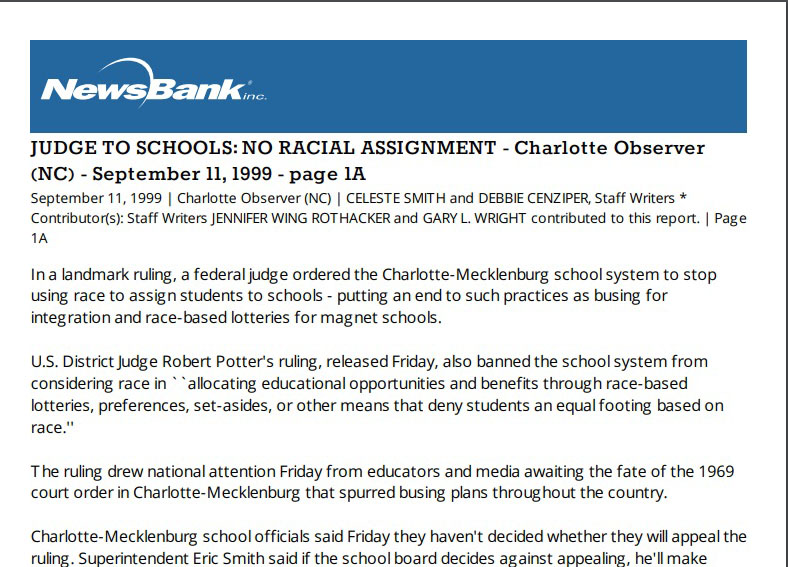School Desegregation
In 1954 the United States Supreme Court ruled in Brown vs. Board of Education that educational facilities separated between the races were inherently unequal, and unconstitutional. The decision mandated that schools across the country were to be integrated, but there was fierce resistance and court battles would persist for decades. Charlotte (and particularly the West End) became ground zero in the nationwide discussion of desegregation. The city often prided itself on being a successful national case for separate but equal with the integration of West Charlotte High School, but the current state of this flagship institution of the West End provides evidence to many that Charlotte’s school system has been slowly but surely re-segregated. Many community activists and concerned citizens see the original problems that existed in the 1950’s emerging again and feel that we are no closer to a solution.
The path to Brown vs. Board of Education had already come through Charlotte and the West End. 15-year old Biddleville resident Dorothy Counts made international headlines when she integrated all-white Harding High School in 1957 to jeers and taunting captured by iconic photographs. The Reverend Joseph DeLaine and his family were residents of rural Clarendon County, S.C. in the 1940s when he helped neighbors file the nation’s first lawsuit demanding the end of segregated schools. Briggs vs. Elliott went to the Supreme Court along with four later suits that resulted in the Brown vs. Board case, and after DeLaine and his family fled South Carolina after violent reprisals from white residents theyeventually ended up settling in the McCrorey Heights neighborhood.
In 1964 another Johnson C. Smith graduate, the Reverend Darius Swann, and his wife tried to enroll their son James in Seversville Elementary School, one of the few integrated schools in the city and one that was much closer to their home on the Westside. The Swanns’ request was denied, and James was required to attend the all-black Biddleville School near the campus of JCSU. The NAACP sued the school board on behalf of the family and nine others, and the case eventually moved to the federal district court in 1969 led by prominent attorney and West End civil rights figure Julius Chambers. The court ruled that the school board must create a student assignment plan aimed at achieving racial balance, and in 1971 the Supreme Court upheld the decision. Swann vs. Charlotte-Mecklenburg Board of Education became, like Brown vs. Board, a landmark case for racial integration.
Court-ordered desegregation in Charlotte lasted for almost 30 years until a white parent sued the school district because he believed his daughter wasn’t admitted into a local magnet school because of her race. In 1999 a Federal District Court judge ordered the district to stop using race in pupil assignments, effectively ending integration. Under the new plan students were largely required to attend the schools in their neighborhood, but decades of housing segregation in the city meant that most neighborhoods were deeply segregated and economically imbalanced. The gradual result of the Swann case had been the reorganization of Charlotte’s neighborhoods, including on the West End, as “white flight” to the suburbs intensified. After the schools began to be integrated, formerly all-white neighborhoods on the West End like Wesley Heights were abandoned to be filled by black residents, and formerly mixed communities like Washington Heights became predominantly black.
Desegregation has a complicated legacy in the Queen City, and that legacy is seen under a microscope in the West End. As the West End undergoes gentrification and the white families that once no longer wanted to live here return, educational institutions in the area face new challenges of growth along with the rest of the corridor.












